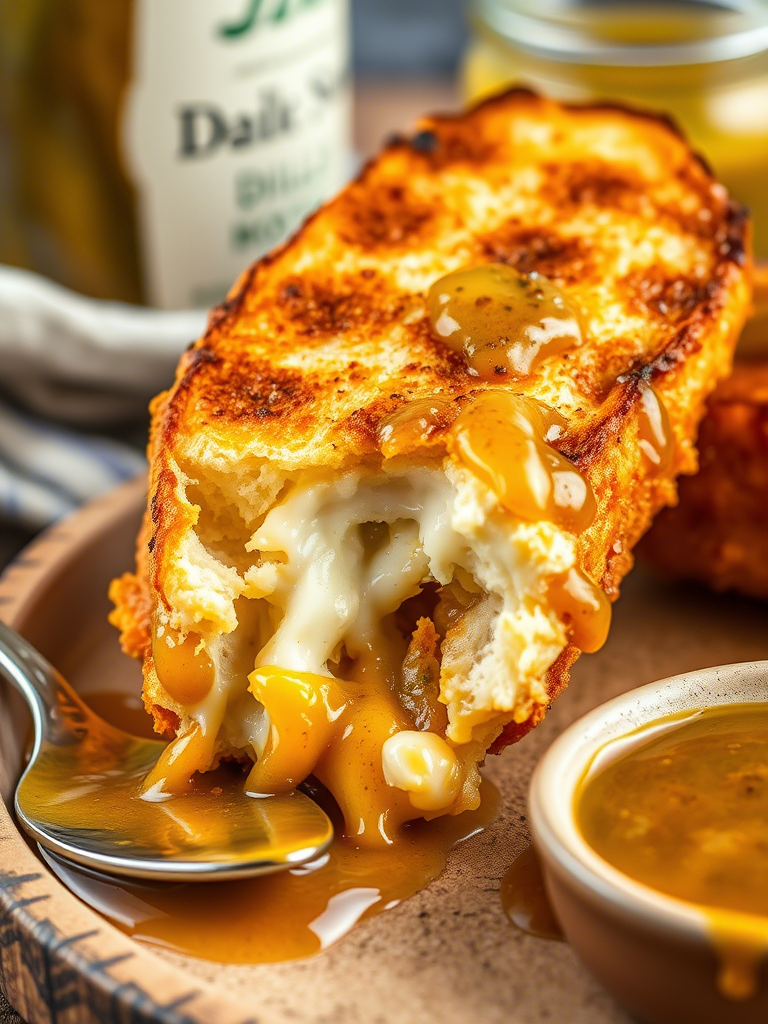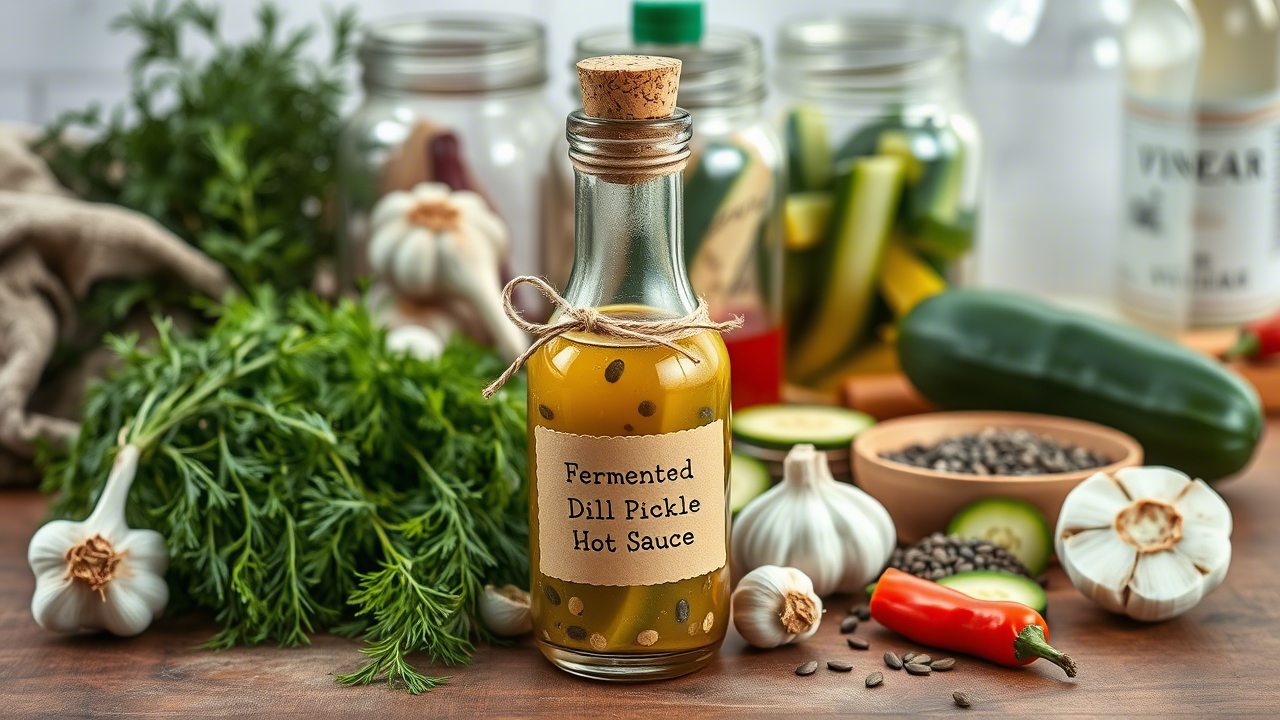What happens when you slam the sharp pucker of dill pickles into the wild fire of hot peppers? You get a flavor bomb that’s confused in the best way possible. Dill Pickle Hot Sauce isn’t just another gimmicky trend. It’s a calculated, acidic, garlicky, briny blaze—engineered to blow past ketchup, mustard, or even your go-to Louisiana-style heat. We’re not talking backyard experiment here; we’re talking serious culinary potential. And for pros in the food world? This is the kind of flavor curveball that flips a menu on its head.
Chefs are no longer asking if they can use dill pickle hot sauce—they’re asking how many ways can we sneak it into dishes before the guests notice. Whether it’s slathered on fried chicken or drizzled over seared tuna, this tang-meets-heat marriage is a conversation-starter, a tongue-tingler, and yeah, a weirdly addictive little devil.
What Exactly Is Dill Pickle Hot Sauce?
Let’s not overthink it—it’s a hot sauce with the essence of dill pickles. But there’s nuance.
Most versions start with vinegar (duh), dill, garlic, and cucumbers—fermented or fresh—plus chili peppers. Sounds simple, but this isn’t just tossing ingredients in a blender. The real deal requires fermentation science, acid balance, heat scaling, and a damn good understanding of aromatic compounds. Jalapeños bring grassy notes, habaneros scream citrus. Fermented cucumbers lend umami. Dill, when fresh, releases that anise-y, piney aroma that cuts through fat like a blade.
The real magic happens in ratios. Too much dill and it tastes like a jar of pickle juice gone rogue. Too little and it’s just hot sauce in green clothes. The point is to tease the palate—make people go “wait, what is that flavor?” And then pour more.
Why It Works: The Science Behind the Flavor Clash
Dill Pickle Hot Sauce isn’t some chaotic accident. It’s rooted in solid food chemistry.
Here’s the deal: pickle brine is acidic and loaded with volatile oils (thanks to garlic, mustard seed, and dill). When you add capsaicin—the spicy compound in peppers—you create a flavor compound that lights up nearly every taste receptor. Sweet? Yes. Salty? Uh-huh. Umami? A touch. Sour? Obviously. Spicy? Definitely.
That’s flavor synergy. Think of it like a band where everyone’s slightly outta tune but it still works—somehow. The acid boosts salivation, the spice activates heat receptors, and the herbs keep the funk classy. No flavor sits quiet in this sauce. Every drop is loud.
Culinary Institute of America studies have shown that balanced acid-heat sauces increase perceived richness in proteins by up to 30%. Translation? Your grilled pork belly suddenly tastes like it came from a Michelin kitchen—just ‘cause you added a few squirts of dill pickle hot sauce.
Building a Proper Dill Pickle Hot Sauce: It’s Not All Brine and Fire
You can’t just dump pickle juice and Tabasco together and call it done. Real craft matters.
Base Ingredients:
- Fresh or fermented cucumbers
- White or apple cider vinegar (some pros use rice vinegar for subtle sweetness)
- Dill (fresh or dried—fresh makes a difference, trust me)
- Garlic (roasted gives depth)
- Peppers (jalapeño, serrano, habanero, or Fresno depending on your fire tolerance)
- Salt (non-iodized—iodine makes the brine taste metallic)
- Optional: coriander seed, mustard seed, celery seed
Methodologies vary, but the elite chefs? They ferment. Fermentation rounds out the sharpness. It softens the sting of raw garlic, pulls back the vinegar bite, and brings that mild funky tang—the kind that makes people wonder if you used anchovy paste (you didn’t).
Lacto-fermentation using salt and time (usually 5-7 days) gives the sauce natural probiotics too. Bonus points for gut health while your mouth’s on fire.
Some chefs even smoke the cucumbers before blending. It’s overkill in some cases, but when paired with grilled meats? Insane.

Where It’s Trending: From Food Trucks to Fine Dining
What’s wild is how this sauce jumped the fence.
At first, it was a fringe condiment. Think: pickle juice addicts, novelty hot sauce collectors, home fermenters with too much time. But then something shifted.
Food trucks started using it on Nashville hot chicken sandwiches. Diners started asking for it. Suddenly it’s showing up in burger chains, vegan bowls, and even Korean-American fusion joints.
Here’s what’s happening in the culinary trenches:
- Portland, OR: A small-batch pickle shop makes a fermented dill hot sauce using smoked Serrano peppers. It’s sold out monthly.
- Brooklyn, NY: A gastropub uses it in a deviled egg mousse. Weird? Yes. Amazing? Also yes.
- Austin, TX: A BBQ truck sprays it (literally) on brisket before slicing. Brine + smoke = mind-melting.
- L.A.: Vegan tacos with dill pickle hot sauce crema. Coconut milk balances the heat. People go nuts for it.
It’s not just U.S.-based. European chefs are tinkering with it too. London’s already got its own pickle hot sauce pop-up.
Pro Applications: How Chefs Are Using It (Without Overdoing It)
The big win here is versatility. A lotta hot sauces punch one note and call it a day. Dill pickle hot sauce plays chords.
1. Eggs. Scrambled, poached, deviled. Just a few dots wakes ’em up.
2. Fries. Think vinegar salt + chili = upgraded poutine with edge.
3. Fried Foods. Pickle spice cuts the grease—whether it’s fried mushrooms or karaage chicken.
4. Sandwiches. Grilled cheese, turkey melts, Cuban paninis—it glues everything together flavor-wise.
5. Bloody Marys. Oh man. Use this instead of Tabasco and never look back. Garnish with a pickled green bean, and you’re in brunch heaven.
The trick is balance. A touch too much and it overtakes. A drizzle though? It makes people pause. Then ask where you got it. Then order another plate.
Shelf Life, Safety, and Scaling: What the Pros Need to Know
Fermented hot sauces are generally shelf-stable if pH is below 4.0. But you can’t just eyeball it.
If you’re making this in a commercial kitchen, you must test the pH. Litmus strips are cheap, but a digital pH meter is a better investment. And yes, the FDA’s got rules around low-acid canned foods, so don’t wing it.
Adding preservatives like citric acid can help extend shelf life. Some use xanthan gum for suspension—especially if your sauce separates after a few hours.
Bottling hot? Let it cool to 180°F to avoid killing the lacto-goodies. And label everything clearly. Consumers love to know what they’re eating.
Emerging Trends: The Next Wave of Pickle Heat
Here’s where things are going. Spoiler: it’s not just green anymore.
- Color Variants. Beet juice turns the sauce fuschia—now it’s “pretty” heat. Carrot and turmeric add gold tones.
- Sweet Heat Blends. Maple syrup or agave in tiny amounts makes the sauce more mellow and caramel-ish.
- International Mashups. Korean gochugaru meets dill pickles. Imagine kimchi and pickles having a spicy baby.
- Dry Versions. Dehydrated dill pickle hot sauce powders for popcorn, wings, or rimmed cocktails. It’s flying off shelves in niche markets.
Big food companies are sniffing around too. Expect to see major brands launching mainstream versions within the year.
Common Mistakes: Don’t Do This, Please
Overdill-ing. Dill is powerful. Too much and you’re drinking bathwater with spice.
Over-vinegaring. Balance matters. Too much acid? You’re basically burning your mouth with salad dressing.
No salt. Salt isn’t optional in brines. It’s what makes it taste like pickles.
Raw garlic overload. Ferment it or roast it. Don’t punish people with raw garlic breath.
Ignoring texture. Strain if needed. Gritty sauce kills the vibe.

Final Thoughts: Why It’s More Than a Novelty
Dill Pickle Hot Sauce isn’t a joke. It’s not a “TikTok-only” trend. It’s a legitimate flavor profile with real range and staying power.
The blend of briney tang, herbaceous dill, and peppery heat is a new frontier in condiments. It challenges the norm. It disrupts plates. It invites experimentation.
And if you’re a chef, mixologist, or food brand not paying attention to it yet—you might just be behind the curve.
This sauce isn’t fading. It’s fermenting deeper into the culinary scene. Better hop on before your competitors pickle-fy their menus first.
FAQs
What is dill pickle hot sauce made of?
It’s usually made from vinegar, dill, garlic, cucumbers, chili peppers, and salt.
Is dill pickle hot sauce really spicy?
It depends on the peppers used—jalapeños are mild, but habaneros bring real heat.
Can I make dill pickle hot sauce at home?
Yes, with simple ingredients and basic fermentation or blending techniques.
How long does homemade dill pickle hot sauce last?
If properly stored and the pH is safe, it can last several months in the fridge.
Does dill pickle hot sauce need to be fermented?
No, but fermentation adds depth and probiotic benefits many prefer.
What foods pair well with dill pickle hot sauce?
Eggs, fried chicken, sandwiches, fries, and even Bloody Marys love it.
Is dill pickle hot sauce healthy?
In moderation, yes—it’s low calorie and fermented versions support gut health.
Can I buy dill pickle hot sauce commercially?
Yes, many small-batch makers and some big brands now offer it.
Is dill pickle hot sauce vegan and gluten-free?
Most versions are, but always check the label to be sure.
Why is dill pickle hot sauce trending?
Because it blends tangy, spicy, and savory notes in one unique, addictive punch.
Ask ChatGPT

Mariana is a passionate home cook who creates delicious, easy-to-follow recipes for busy people. From energizing breakfasts to satisfying dinners and indulgent desserts, her dishes are designed to fuel both your body and hustle.
When she’s not in the kitchen, she’s exploring new flavors and dreaming up her next recipe to share with the Foodie Hustle community.

